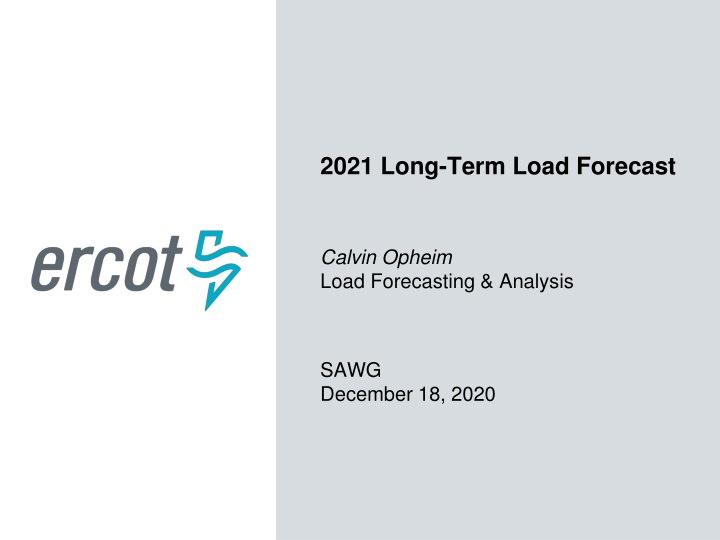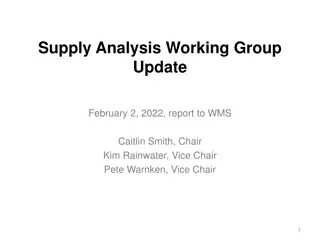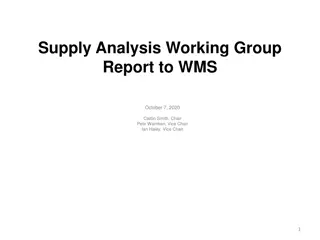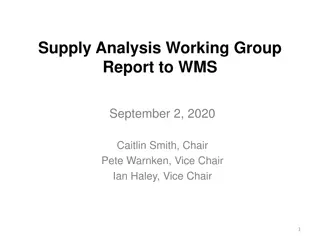
Long-Term Load Forecasting Analysis and Model Development
"Explore the comprehensive analysis and development models for long-term load forecasting. Delve into growth drivers, weather zones, input data variables, and premise forecasts to enhance energy management strategies. Discover unique models for each weather zone and premise class, along with essential data on temperature, energy efficiency, and load adjustments."
Download Presentation

Please find below an Image/Link to download the presentation.
The content on the website is provided AS IS for your information and personal use only. It may not be sold, licensed, or shared on other websites without obtaining consent from the author. If you encounter any issues during the download, it is possible that the publisher has removed the file from their server.
You are allowed to download the files provided on this website for personal or commercial use, subject to the condition that they are used lawfully. All files are the property of their respective owners.
The content on the website is provided AS IS for your information and personal use only. It may not be sold, licensed, or shared on other websites without obtaining consent from the author.
E N D
Presentation Transcript
2021 Long-Term Load Forecast Calvin Opheim Load Forecasting & Analysis SAWG December 18, 2020
Agenda Data Used in Model Development Growth Driver Creating Weather Zone Load Forecasts Creating the ERCOT System Load Forecast ERCOT System Load Forecast 2 PUBLIC
Agenda - continued Rooftop PV Forecast Forecast Adjustments Assumptions and Challenges Weather Zone Forecast Summary Questions 3 PUBLIC
Weather Zones 2 or 3 Weather Stations in each Weather Zone 5 PUBLIC
Load Models Unique Model for Each Weather Zone Each Temperature Group i. Hot ii. Medium iii. Cold 6 PUBLIC
Input Data Hourly Models From January 2015 through August 2020 Recent Snapshot Appliance Stock Energy Efficiency Demand Response Price Responsive Load 7 PUBLIC
Input Data Weather Temperature, Temperature Squared, and Temperature Cubed Cooling Degree Days and Heating Degree Days Cloud Cover Wind Speed Dew Point 8 PUBLIC
Input Data Calendar Month Day of the Week Holidays Hour Interact Hour with Day of the Week 9 PUBLIC
Input Data Variable Interactions Interact a Weather Variable with a Calendar Variable Temperature with Hour Dew Point with Hour Interact multiple Weather Variables with a Calendar Variable Temperature with Dew Point and Hour 10 PUBLIC
Premise Forecast Unique Model for Each Weather Zone Each Premise Class i. Residential ii. Commercial iii. Industrial Monthly Models 12 PUBLIC
Input Data From January 2015 through August 2020 Economic Measures Population Non-Farm Employment Housing Stock Error Correction Term 13 PUBLIC
Challenges Far West Historical Premise Counts 250,000 200,000 Premise Counts increased significantly via opt-in 150,000 Premise Count 100,000 50,000 - May-09 May-10 May-11 May-12 May-13 May-14 May-15 May-16 May-17 May-18 Jan-09 Jan-10 Jan-11 Jan-12 Jan-13 Jan-14 Jan-15 Jan-16 Jan-17 Jan-18 Sep-09 Sep-10 Sep-11 Sep-12 Sep-13 Sep-14 Sep-15 Sep-16 Sep-17 Sep-18 Residential Business 14 PUBLIC
Challenges West Historical Premise Counts 180,000 160,000 140,000 120,000 Premise Counts increased significantly via opt-in Premise Count 100,000 80,000 60,000 40,000 20,000 - May-09 May-10 May-11 May-12 May-13 May-14 May-15 May-16 May-17 May-18 Jan-09 Jan-10 Jan-11 Jan-12 Jan-13 Jan-14 Jan-15 Jan-16 Jan-17 Jan-18 Sep-09 Sep-10 Sep-11 Sep-12 Sep-13 Sep-14 Sep-15 Sep-16 Sep-17 Sep-18 Residential Business 15 PUBLIC
Growth Driver for Far West and West Economic Measures from Moody s Base Scenario Population Non-Farm Employment Housing Stock 16 PUBLIC
Example - Coast Coast 2021 Gross Summer Peak Forecasts Based on Historical Weather Years Forecast (MW) 21,157 20,532 20,431 20,411 20,401 Year 2021 2021 2021 2021 2021 Month 8 8 8 8 8 Day 14 8 8 14 13 Hour 17 16 17 16 17 Rank 1 2 3 4 5 Sort from high to low 18 PUBLIC
Example - Coast Coast 2021 Gross Summer Peak Forecasts Based on Historical Weather Years Forecast (MW) 21,157 20,532 20,431 20,411 20,401 Year 2021 2021 2021 2021 2021 Month 8 8 8 8 8 Day 14 8 8 14 13 Hour 17 16 17 16 17 Rank 1 2 3 4 5 Sort from high to low Rank 2005 2006 2007 2008 2009 2010 2011 2012 2013 2014 2015 2016 2017 2018 2019 1 21,157 21,103 21,600 21,091 21,968 21,539 22,344 22,793 21,628 21,167 22,157 21,745 21,049 21,289 22,044 2 20,532 20,936 21,472 20,728 21,374 21,425 22,312 21,321 21,281 21,131 22,091 21,452 21,029 21,231 21,973 3 20,431 20,864 21,426 20,716 21,311 21,258 22,287 21,261 21,251 21,089 21,659 21,391 20,847 21,151 21,922 4 20,411 20,583 21,374 20,627 21,254 21,257 22,170 21,197 21,213 20,993 21,615 21,367 20,810 21,105 21,909 5 20,401 20,546 21,316 20,617 21,199 21,204 22,119 21,169 21,202 20,990 21,570 21,301 20,807 21,072 21,892 19 PUBLIC
Example - Coast Coast 2021 Gross Summer Peak Forecasts 23,000 22,793 22,500 22,344 22,157 22,044 21,968 22,000 21,745 21,628 21,600 21,539 MW 21,500 21,289 21,167 21,157 21,103 21,091 21,049 21,000 20,500 20,000 2005 2006 2007 2008 2009 2010 2011 Historical Weather Year 2012 2013 2014 2015 2016 2017 2018 2019 20 PUBLIC
Example - Coast Coast 2021 Gross Summer Forecasts Based on Historical Weather Years Rank 2005 2006 2007 2008 2009 2010 2011 2012 2013 2014 2015 2016 2017 2018 2019 Average 1 21,157 21,103 21,600 21,091 21,968 21,539 22,344 22,793 21,628 21,167 22,157 21,745 21,049 21,289 22,044 21,645 2 20,532 20,936 21,472 20,728 21,374 21,425 22,312 21,321 21,281 21,131 22,091 21,452 21,029 21,231 21,973 21,353 3 20,431 20,864 21,426 20,716 21,311 21,258 22,287 21,261 21,251 21,089 21,659 21,391 20,847 21,151 21,922 21,258 4 20,411 20,583 21,374 20,627 21,254 21,257 22,170 21,197 21,213 20,993 21,615 21,367 20,810 21,105 21,909 21,192 5 20,401 20,546 21,316 20,617 21,199 21,204 22,119 21,169 21,202 20,990 21,570 21,301 20,807 21,072 21,892 21,160 21 PUBLIC
Example - Coast Coast 2021 Gross Summer Peak Forecasts 23,000 22,793 22,793 22,500 22,344 22,157 22,044 21,968 22,000 21,745 21,645 21,628 21,600 21,539 MW 21,500 21,289 21,167 21,15721,103 21,091 21,049 21,049 21,000 20,500 20,000 Historical Weather Year 22 PUBLIC
Creating Weather Zone Load Forecasts Summary For every weather zone For every forecasted year (2021-2030) Forecasted values are ranked from high to low for each month The average is calculated for each rank This is the gross normal weather load forecast Does not include impacts of the rooftop PV forecast 23 PUBLIC
Creating the ERCOT System Forecast - Example For every weather zone, retrieve the actual load values from calendar year 2008 Sort the values from high to low Coast Historical Year Actual Load (MW) Month Day Hour Rank 2008 8 1 17 1 17,623 Sort from high to low 2008 8 1 16 2 17,478 2008 8 1 18 3 17,463 2008 8 8 17 4 17,222 2008 8 8 18 5 17,184 Coast 2008 Summer Actual Load 25 PUBLIC
Creating the ERCOT System Forecast - Example Assign the average forecast values by rank (from slide 22) to the same rank based on the actual load from 2008 Coast 2021 Gross Forecast (MW) Month Day Hour Rank 8 1 17 1 21,645 8 1 16 2 21,353 8 1 18 3 21,258 8 8 17 4 21,192 8 8 18 5 21,160 Coast 2021 Gross Forecast Based on 2008 Calendar 26 PUBLIC
Creating the ERCOT System Forecast - Example Coast 2021 Gross Forecast (MW) Month Day Hour Rank 8 1 17 1 21,645 8 1 16 2 21,353 8 1 18 3 21,258 8 8 17 4 21,192 8 8 18 5 21,160 Forecast Year Month Day Hour Coast East Fwest Ncent North Scent South West 2021 8 4 17 20,880 2,726 4,850 26,055 1,898 12,957 5,808 2,069 2021 8 1 17 21,645 2,811 4,818 25,263 1,850 12,202 5,756 1,896 2021 8 4 18 20,628 2,751 4,835 25,630 1,867 12,688 5,698 2,003 2021 8 4 16 20,792 2,742 4,804 25,568 1,860 12,527 5,773 1,998 2021 8 7 17 21,064 2,734 4,736 25,151 1,800 12,407 5,938 1,944 27 PUBLIC
Creating the ERCOT System Forecast - Example Coast 2021 Gross Forecast (MW) Month Day Hour Rank 8 1 17 1 21,645 8 1 16 2 21,353 8 1 18 3 21,258 8 8 17 4 21,192 8 8 18 5 21,160 ERCOT Gross Forecast (MW) Based on 2008 Calendar Forecast Year Month Day Hour Coast East Fwest Ncent North Scent South West ERCOT 2021 8 4 17 20,880 2,726 4,850 26,055 1,898 12,957 5,808 2,069 77,244 2021 8 1 17 21,645 2,811 4,818 25,263 1,850 12,202 5,756 1,896 76,242 2021 8 4 18 20,628 2,751 4,835 25,630 1,867 12,688 5,698 2,003 76,101 2021 8 4 16 20,792 2,742 4,804 25,568 1,860 12,527 5,773 1,998 76,066 2021 8 7 17 21,064 2,734 4,736 25,151 1,800 12,407 5,938 1,944 75,772 28 PUBLIC
ERCOT Forecast Summary Forecasts for each Weather Zone are mapped into a Historical Calendar by Rank 2008 Historical Calendar was selected Evaluated 2007 through 2018 2008 had the least amount of diversity between Weather Zone peaks and ERCOT peak 29 PUBLIC
Historical Coincident Factors Scenario Forecasts 88,000 ERCOT Gross Summer Peak Forecasts 86,000 84,000 82,000 80,000 MW 78,000 76,000 74,000 7 7 , 2 4 4 7 6 , 4 4 0 7 5 , 2 4 9 7 8 , 8 5 5 7 8 , 0 5 3 7 6 , 8 6 4 8 0 , 2 8 0 7 9 , 4 8 0 7 8 , 2 9 3 8 1 , 2 6 7 8 0 , 4 6 8 7 9 , 2 8 2 8 2 , 0 5 8 8 1 , 2 5 9 8 0 , 0 7 5 8 2 , 8 3 8 8 2 , 0 3 9 8 0 , 8 5 5 8 3 , 6 1 6 8 2 , 8 1 5 8 1 , 6 3 2 8 4 , 3 6 2 8 3 , 5 6 1 8 2 , 3 7 8 8 5 , 0 9 5 8 4 , 2 9 5 8 3 , 1 1 1 8 5 , 8 2 0 8 5 , 0 2 1 8 3 , 8 3 7 72,000 70,000 68,000 2021 2022 2023 2024 2025 2026 2027 2028 2029 2030 Year 2008 Coincident Factors Average Coincident Factors Minimum Coincident Factors 30 PUBLIC
ERCOT Gross Summer Peak Demand Forecast 90,000 85,000 2021, 77,244 80,000 2030, 85,820 75,000 MW 70,000 2020, 74,328 65,000 60,000 55,000 2002, 56,068 50,000 2002 2004 2006 2008 2010 2012 2014 2016 Year 2018 2020 2022 2024 2026 2028 2030 Actual Forecast 32 PUBLIC
ERCOT Gross Summer Peak Forecast 95,000 90,000 85,000 80,000 MW 75,000 70,000 7 8 , 2 9 9 7 7 , 2 4 4 8 0 , 1 0 8 7 8 , 8 5 5 8 1 , 5 9 3 8 0 , 2 8 0 8 2 , 9 8 2 8 1 , 2 6 7 8 4 , 1 9 3 8 2 , 0 5 8 8 5 , 3 8 4 8 2 , 8 3 8 8 6 , 5 4 6 8 3 , 6 1 6 8 7 , 6 6 8 8 4 , 3 6 2 8 8 , 7 5 1 8 5 , 0 9 5 8 9 , 8 1 4 8 5 , 8 2 0 65,000 60,000 2021 2022 2023 2024 2025 2026 2027 2028 2029 2030 Year 2020 LTLF 2021 LTLF 33 PUBLIC
ERCOT Annual Energy Forecast 600,000 500,000 400,000 GWh 300,000 200,000 4 1 1 , 2 5 0 4 0 5 , 8 4 2 4 2 4 , 8 3 1 4 1 9 , 6 1 6 4 3 7 , 9 2 1 4 3 4 , 0 0 6 4 4 9 , 9 6 9 4 4 4 , 4 2 6 4 5 8 , 2 6 3 4 5 0 , 6 7 6 4 6 7 , 4 1 6 4 5 7 , 8 5 4 4 7 6 , 3 7 3 4 6 4 , 9 0 3 4 8 6 , 2 2 0 4 7 2 , 9 5 0 4 9 3 , 4 1 5 4 7 8 , 5 1 0 5 0 1 , 6 2 2 4 8 5 , 1 4 3 100,000 0 2021 2022 2023 2024 2025 2026 2027 2028 2029 2030 Year 2020 LTLF 2021 LTLF 34 PUBLIC
ERCOT Annual Energy Forecast 600,000 2030, 485,143 500,000 2021, 405,842 400,000 2020, 382,248 GWh 300,000 2002, 279,881 200,000 100,000 0 2002 2004 2006 2008 2010 2012 2014 2016 Year 2018 2020 2022 2024 2026 2028 2030 Actual Forecast December forecasted 35 PUBLIC
Rooftop PV Forecast This is the first year that a rooftop PV forecast was created A forecast was created for residential ESIIDs using the load profile assignment for each weather zone Total installed capacity was approximately 700 MW as of August, 2020 Forecast is for the total installed capacity to increase to approximately 2,100 MW by August, 2030 The assumed capacity factor at the time of the summer peak is 46% The gross forecast minus the rooftop PV forecast results in the net forecast 37 PUBLIC
Rooftop PV Forecast - Approach 8/14/2020 5.0 4.5 17, 4.0 4.0 3.5 3.0 kW 2.5 2.0 17, 2.1 1.5 1.0 0.5 0.0 1 2 3 4 5 6 7 8 9 10 11 12 13 14 15 16 17 18 19 20 21 22 23 24 Hour Residential with PV Residential w/o PV 38 PUBLIC
Rooftop PV Forecast - Approach 7/13/2020 5.0 4.5 17, 4.0 4.0 3.5 3.0 kW 2.5 2.0 17, 2.2 1.5 1.0 0.5 0.0 1 2 3 4 5 6 7 8 9 10 11 12 13 14 15 16 17 18 19 20 21 22 23 24 Hour Residential with PV Residential w/o PV 39 PUBLIC
Rooftop PV Forecast - Approach Data from ERCOT s monthly peak day in July (7/13/2020) and August (8/14/2020) was used Calculate the total hourly demands for residential ESIIDs with PV Calculate the total hourly demands for residential ESIIDs without PV Divide the total hour demand values by the number of ESIIDs (result is an average use per ESIID with and without PV) Divide the average use per ESIID with PV by the average use per ESIID without PV for each hour (call this the PV hourly factors) Multiply the PV hourly factors by the forecasted number of PV Premises 40 PUBLIC
Rooftop PV Forecast - Approach Use the PV hourly factor for hour 17 to create the PV Summer Peak forecast Subtract out the current contribution of PV (as of August, 2020) Assume no PV output at the time of the winter peak which is typically 8 a.m. Assume the same PV hourly factor for residential and business ESIIDs This is a work in progress. More analysis will be performed in 2021. 41 PUBLIC
Rooftop PV Forecast Rooftop PV Forecast (MW) at Time of Summer Peak 700 600 500 400 MW 300 200 100 0 2021 2022 2023 2024 2025 2026 2027 2028 2029 2030 Year 42 PUBLIC
Observations Residential ESIIDs with PV have greater average usage per hour than ESIIDs without PV during the early morning and evening hours Some studies suggest that customers with PV tend to use more energy To compensate for this, should the shapes be unitized? 43 PUBLIC
Load Forecast Adjustments Lubbock added to North Forecast from 2021 on Based on Lubbock s Peak Forecast of its growth Fiber Services in Lubbock, TX. About NTS, NTS Communications, Inc., 2018, www.ntscom.com/aboutnts/primary-locations/lubbock-tx. 45 PUBLIC
Load Forecast Adjustments Rayburn added to East Forecast from 2021 on Based on Rayburn s Actual Seasonal Peaks in 2019 RCEC. PROJECTS>OFFICE>RCEC, Alliance Architects, 2019, www.alliancearch.com/projects/office/rcec/. 46 PUBLIC
Load Forecast Adjustments Adjustments added for Large Industrial Facilities Coast 425 650 MW phased in over time South 75 930 MW phased in over time South Central 24 480 MW phased in over time 47 PUBLIC
Assumptions Inherent Levels from the Input Data of Appliance Stock and Energy Efficiency Demand Response 4 CP Impact Behind-the-Meter DG (non rooftop solar) Price Responsive Load Electric Vehicles (significant impact on future forecasts) 49 PUBLIC
Challenges Weather Volatility Economic Uncertainty Policy Impacts 50 PUBLIC






















